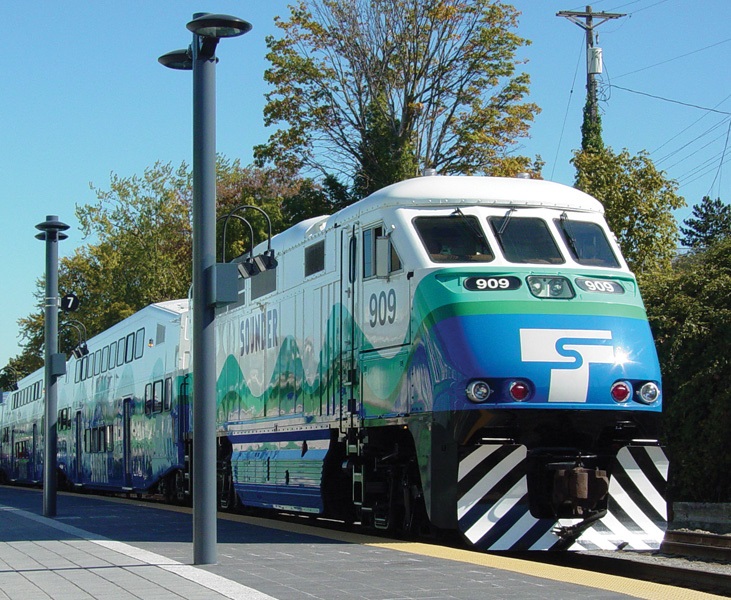Clayton County commuters could be riding diesel-powered trains between East Point and Lovejoy by the end of the next decade.
MARTA Board of Directors – metro Atlanta’s top transit officials – recently approved the long-awaited passenger rail line through Clayton, which is a key step in securing federal financing for the project. The 22-mile rail line would link MARTA’s East Point station to Jonesboro and Lovejoy. It would most likely run alongside existing Norfolk Southern tracks although those details have yet to be worked out.
The rail line is vital to enhancing commuting options beyond the county’s current MARTA bus system and attracting more economic development on metro Atlanta’s southside. It would be the first light-rail system in metro Atlanta and would use diesel-powered trains similar to those in New York, Chicago and Seattle, according to Clayton County Chief Operating Officer Detrick Stanford.
“It provides a segue for businesses to consider relocating south of Atlanta and it fulfills our opportunity to connect with the city of Atlanta and other parts of the region,” Stanford said.
“With the MARTA board supporting this commuter rail to come south…it has taken a discussion to a true action plan,” Stanford added. “It brings to bear the work of many stakeholders over the last 20-plus years to really see this come to life now.”
“The southside is really getting some attention,” Stanford said. “People are recognizing there’s growth opportunities on the southside that really should be taken advantage of. More importantly, Clayton County is now a part of that discussion.”
Come Home To Clayton Publisher Altimese Dees and reporter Tammy Joyner recently sat down with MARTA executives Ben Limmer and Tracy Roberson to discuss details about the East Point-Lovejoy commuter rail line. Limmer is assistant general manager of planning. Roberson is project manager for the Clayton Transit Initiative.
MARTA Board of Directors approved two transit plans. What does it mean for Clayton County?
BL: The action taken (by the board) recommended two transit investments. (The board’s decision) advances (the projects) to the federal planning process. The commuter rail from East Point to Lovejoy will be 22 miles and the bus rapid transit will run along state route 85 and state route 139. (They) will be high-quality, high-frequency buses running on their own dedicated lane or things that help speed the buses up.
Now that the projects have the green light, how long will the process take?
TR: That could be a 12-18 month process for the environmental phase. It’s part of the process to get federal funding from the government.
What was the catalyst that helped get this project launched?
BL: The vote in 2014 was specific around what the voters were voting on. There was a bus system. A bus plan and then the commuter rail line. That was the catalyst. MARTA’s job is to implement what the voters voted on.
What had been the holdup in the past?
BL: There wasn’t a local funding source to advance the project.
Any sticking points going forward?
TR: We’ve done details and a tremendous job of including stakeholders and keeping them in the loop and because voters voted, the community is completely committed to this and so is MARTA. I don’t see any particulars right now that would derail the project.
When could Clayton residents be riding the East Point-to-Lovejoy rail?
TR: This project would require both local and federal funding and several phases to go through to qualify for the federal funding. There’s a lot of things we don’t necessarily know right now as it relates to engineering, where stations are going to be and how they’ll be designed. Once we get there, we’ll have more of an idea. Commuter rails, in general when we look at peer agencies, (and take into account) planning, environmental, engineering, design and construction spans from six to 10 years, depending on the actual design. 2028 is the range right now.
BL: We will know a lot more once we design it and get a better feel for what kind of project we’re looking at.
TR: (The bus rapid transit) will likely be in place before rail.
How far along are talks with Norfolk Southern?
TR: Coordination with Norfolk began immediately after the sales tax was passed. So we’ve been in coordination with Norfolk Southern since early 2015.
What has been their response?
TR: They’re willing to work with us. Now that we’ve gotten to this milestone of getting this final board approval, it opens up the window to going into further communication and coordination with them. Thus far, the conversation has been positive.
Is this going to cost Clayton residents beyond what they’ve already committed to pay?
BL: No. The one-cent tax they passed in 2014 is assumed that it will be able to fund the construction of the commuter rail line as well as the bus route, transit plus pay for the annual operating costs.
How much will it cost to build the commuter line?
BL: We don’t have the cost yet.
Are we talking millions or billions of dollars?
BL: It depends on how long it is, but it will be in the millions. Commuter rails can be much less expensive if you’re able to work with the railroad and share their track. But the condition we’re looking at here is we would construct a new track that would be next to Norfolk Southern which makes it more expensive. Generally, we’re talking about $50 million a mile (based on national comparisons). Ours could be more or less.
What are the benefits of having a commuter Lovejoy line?
TR: Providing access to jobs and education, improving general travel options, getting people connected to the region, supporting land use and economic development and addressing growing demand for transit in Clayton. We have a high dependency on transit in the county. Having a commuter rail addresses all of these needs for the county. These needs were identified by the constituents and residents.
How can the county keep people engaged in this project and how can MARTA play a part in that?
BL: The key ingredient to success is to partner with the county to do continuous and ongoing outreach to stakeholders, customers and the business community to really make sure we provide them with the information on what this investment could mean for the county. So that’s really MARTA and the county’s commitment to implementing this commuter rail.
Photo: Courtesy of Sound Transit. The commuter rail shown is the “Sounder,” located in Seattle, Washington.
#comehome2clayton

